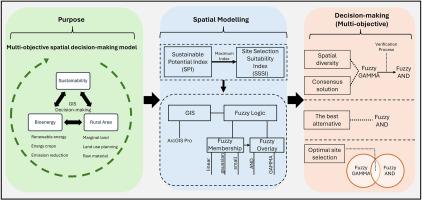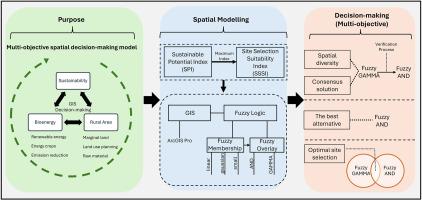农村地区生物能源设施可持续性的多目标空间决策模型——以浙江为例
IF 10
1区 环境科学与生态学
Q1 ENGINEERING, ENVIRONMENTAL
引用次数: 0
摘要
本研究旨在提出基于农业和动物生物质资源的农村生物能源设施可持续性的空间方法和模型。案例研究包含了两阶段的空间决策方法。第一阶段是基于生产区参数对生物质资源进行评价,确定区域可持续潜力指数(SPI)值。第二阶段涉及选址适宜性指数(SSSI)过程,该过程考虑SPI值最高的地区的经济、环境、技术和规划参数。基于模糊逻辑- gis关系的空间决策模型,在ArcGIS Pro软件中使用模糊GAMMA和模糊and算子实现。研究发现,模糊GAMMA算子使空间决策方案多样化,而模糊AND算子对决策过程中最佳方案的识别结果较为合理。在研究范围内,基于模糊伽马和集成的开发模型扩大了备选方案的范围,并在确定最佳位置和备选方案方面取得了成功的空间结果。基于gis的模糊和伽马综合方法为决策者提供了生物能源设施选址和农村可持续性的重要框架,并取得了成功的结果。开发的空间方法和模型强调决策过程的多目标性质,展示了客观决策的适用性和成功性。本文章由计算机程序翻译,如有差异,请以英文原文为准。


Multi-objective spatial decision-making model for the sustainability of bioenergy facilities in rural areas: A case study in Türkiye
This study aims to present the spatial approach and model for ensuring the sustainability of bioenergy facilities based on agricultural and animal biomass resources in rural areas. The case study encompasses a two-stage spatial decision-making approach. The first stage involves evaluating biomass resources based on production area parameters to determine the regional sustainable potential index (SPI) value. The second stage involves the site selection suitability index (SSSI) process, which considers economic, environmental, technical, and planning parameters in the area with the highest SPI value. The spatial decision-making model, based on the fuzzy logic-GIS relationship, was implemented in ArcGIS Pro software using fuzzy GAMMA and fuzzy AND operators. The study found that the fuzzy GAMMA operator diversifies spatial decision-making alternatives, whereas the fuzzy AND operator produces rational results for identifying the best alternative in the decision-making process. Within the scope of the study, the developed model based on fuzzy GAMMA-AND integration expands the range of alternatives and yields successful spatial outcomes in identifying the optimal location and alternative options. The GIS-based approach based on fuzzy AND-GAMMA integration has provided decision-makers with a significant framework for site selection of bioenergy facilities and rural sustainability, yielding successful results. The developed spatial approach and model emphasize the multi-objective nature of decision-making processes, demonstrating the applicability and success of objective decision-making.
求助全文
通过发布文献求助,成功后即可免费获取论文全文。
去求助
来源期刊

Journal of Cleaner Production
环境科学-工程:环境
CiteScore
20.40
自引率
9.00%
发文量
4720
审稿时长
111 days
期刊介绍:
The Journal of Cleaner Production is an international, transdisciplinary journal that addresses and discusses theoretical and practical Cleaner Production, Environmental, and Sustainability issues. It aims to help societies become more sustainable by focusing on the concept of 'Cleaner Production', which aims at preventing waste production and increasing efficiencies in energy, water, resources, and human capital use. The journal serves as a platform for corporations, governments, education institutions, regions, and societies to engage in discussions and research related to Cleaner Production, environmental, and sustainability practices.
 求助内容:
求助内容: 应助结果提醒方式:
应助结果提醒方式:


